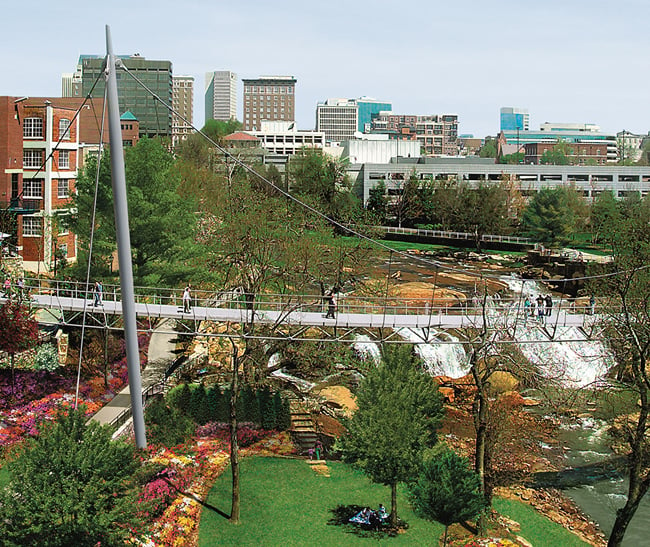
June 5, 2015
A River Corridor “Frees the Falls,” Transforms Downtown Greenville
The next stop for the Bruner Foundation team on their tour of site visits was in Greenville, South Carolina, where a forgotten 40-foot tall waterfall was transformed into an urban oasis and centerpiece for the city.
After visiting Uptown District in Cleveland, the Bruner Foundation team headed south to Greenville, South Carolina, for the last of our site visits to the five 2015 Rudy Bruner Award for Urban Excellence finalists.

Falls Park on the Reedy in Greenville, SC.
Courtesy Rosales+Partners
Located in the center of downtown Greenville, South Carolina, in the foothills of the Blue Ridge Mountains, Falls Park on the Reedy is an urban oasis and centerpiece for the city— thanks to the transformation of a forgotten 40-foot tall waterfall and overgrown river valley.
The park, completed in 2004, is the realization of a vision that began with a 1907 “Beautifying and Improving Greenville, South Carolina” report sponsored by the local municipal league that identified the river falls and gorge as “the most distinctive feature in the topography and landscape of Greenville.” Liberating the falls and creating a park was advanced by the Carolina Foothills Garden Club, which led an effort to establish the park beginning in 1967 and engaged Washington DC-based landscape architect Andrea Mains in 1987 to complete a master plan.

A new pedestrian bridge replaces a four lane vehicular one that covered the falls.
Courtesy City of Greenville
Development of the 26-acre park included replacing a four-lane vehicular bridge built directly over the falls with an elegant, curving, pedestrian suspension bridge designed by Boston-based Rosales+Partners. The award-winning bridge appears to float above the river, offering a dramatic overlook of the falls, and it has become a signature of the park and city. A series of stone steps, gently sloping ADA accessible ramps, and an elevator provide connections between the city’s Main Street and the river valley 65 feet below.

Buildings on Main Street overlook a broad lawn that offers space for play, picnics, and special events.
Courtesy Bruner Foundation
The park offers a series of sweeping vistas and winding trails interspersed with manicured greens and wooded valleys that connect the city with the river and support a diversity of activities such as walking and cycling, quiet contemplation, and picnics, as well as large events like the annual Reedy River Duck Derby. Plantings include a mix of mature trees and native plants, supplemented with vibrant annuals that provide splashes of color at key areas.

Crowds gather to watch thousands of little yellow rubber duckies traverse the falls during the annual Reedy River Duck Derby.
Courtesy Bruner Foundation
Falls Park was completed under the leadership of Mayor Knox White with public funding, largely comprised of proceeds from the city’s hospitality tax. The $13.5 million investment has yielded impressive economic and social returns. The park has influenced nearly $600 million in development, including $65 million in new waterside hotels, housing, offices, and retail at RiverPlace. It is part of a growing network of green spaces including the 17-mile Swamp Rabbit Trail that links downtown with nearby parks, neighborhoods and public amenities.

New residential, office, and retail development at RiverPlace extends downtown activity northward along the river.
Courtesy Bruner Foundation
More than anything, the park has created a popular outdoor “living room” in the heart of downtown that attracts a wide spectrum of the population and has become closely associated with the city’s civic identity. According to White: “The park raised the bar for the community’s self-identity and sense of pride.”
Next, we head to Little Rock, Arkansas, where the selection committee will determine the 2015 Rudy Bruner Award for Urban Excellence medalists.
Noteworthy News:
- Five cities selected for the City Accelerator Initiative, sponsored by Citi Foundation and Living Cities
- NEA awards $74 million through Art Works and State and Regional Partnerships.
- Urban Land Institute’s America in 2015 survey identifies what Americans want in their communities
- ArtPrize announces the 2015 panel of jurors
Anne-Marie Lubenau, AIA, is director of the Rudy Bruner Award for Urban Excellence (RBA) for the Bruner Foundation in Cambridge, Massachusetts. An architect and advocate for educating and engaging people in design of the built environment, she is a graduate of Carnegie Mellon University and was a 2012 Loeb Fellow at the Harvard Graduate School of Design.
This post is part of a series written and curated by RBA that focuses on advancing the conversation about placemaking in American cities. The blog offers a detailed look at the 2015 award selection process and site visits, winners’ case studies, highlights from events such as the Bruner-Loeb Forum, and broader observations.
Recent Viewpoints
Viewpoints
Navigating the Path to Net Zero





